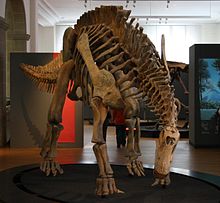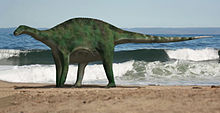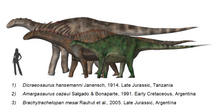Brachytrachelopan
| Brachytrachelopan | |
|---|---|

| |
| Restored skeleton | |
| Scientific classification | |
| Domain: | Eukaryota |
| Kingdom: | Animalia |
| Phylum: | Chordata |
| Clade: | Dinosauria |
| Clade: | Saurischia |
| Clade: | †Sauropodomorpha |
| Clade: | †Sauropoda |
| Superfamily: | †Diplodocoidea |
| Family: | †Dicraeosauridae |
| Genus: | †Brachytrachelopan Rauhut et al. 2005 |
| Species: | †B. mesai
|
| Binomial name | |
| †Brachytrachelopan mesai Rauhut et al. 2005
| |
Brachytrachelopan is a short-necked
Description


This
Distinguishing characteristics
Rauhut et al. (2005, 670) diagnose Brachytrachelopan as differing from all other sauropods in the following respects: "...individual cervical vertebrae being as long as, or shorter in anteroposterior length than, high posteriorly. Further
Classification
Brachytrachelopan belongs to Sauropoda and Neosauropoda from the group of Diplodocoidea and family Dicraeosauridae.[1]
Following a
The following cladogram by Tschopp and colleagues (2015) shows the presumed relationships between members of the Dicraeosauridae:[3]

| Dicraeosauridae |
| ||||||||||||||||||||||||||||||
Paleoecology

Rauhut and colleagues in 2005 noted that the tendency towards shorter-necks seen in dicraeosaurids, and most evident in Brachytrachelopan, runs counter to the lengthening of the neck seen in most sauropod lineages (
References
- ^ S2CID 4385136.)
{{cite journal}}: CS1 maint: multiple names: authors list (link - OCLC 985402380.
- PMID 25870766.
